131st Evacuation Hospital Unit History

Photo illustrating Gate No. 1 at Fort Jackson, South Carolina, the location where the 131st Evacuation Hospital was activated and trained before deployment in the European Theater.
Activation:
The 131st Evacuation Hospital (Semimobile) was officially activated at Fort Jackson, Columbia, South Carolina (Infantry Training Center: total, acreage 58,653, with a troop capacity for 5,097 Officers & 72,817 EM -ed) 20 March 1944 by Letter, Office of the Commanding Officer, Headquarters Second United States Army, Memphis 15, Tennessee, Subject: “Letter Orders No. A 3-9, Activation of 130th and 131st Evacuation Hospitals, 400-bed, (Semimobile)”, dated 11 March 1944.
Training:
Apart from Basic Training destined to help the personnel become proficient in basic military subjects, the peculiar training and instruction required for administration and operation of a medical unit was also included in the 12-week Mobilization Training Program (MTP) which comprised both tactical and technical training. It was important that the staff and personnel learned the specific objectives and operations of an Evacuation Hospital serving overseas.
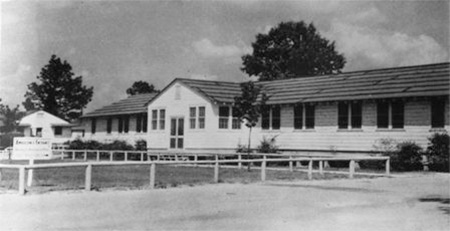
Photo of the Station Hospital, Fort Jackson. This was the hospital were many a personnel of the 131st Evacuation Hospital received some of their technical training.
Final training took place at Fort Jackson, Columbia, together with elements of the 1st Convalescent Hospital and the 130th Evacuation Hospital where the men practiced reviews, parades, formations, and inspections. Some of the personnel were sent on TDY at the Station Hospital to become familiar with specific aspects related to medical treatment and improve their skills, while others went to specialized schools to learn more trades.
Preparation for Overseas Movement:
According to Medical Department objectives the Evacuation Hospital was to provide, as near to the frontlines as practicable, facilities for major medical and surgical procedures. Its task was to establish additional facilities for the concentration of evacuees in such numbers and at such locations that their evacuation and transfer could be undertaken by carrier (truck, ambulance, hospital train, etc) economically. Moreover the Evacuation Hospital was to provide opportunities and facilities for beginning definitive treatment as early as possible.
Mid October 1944, 41 ANC Officers joined the unit in training before deployment overseas. The entire unit finally began waterproofing, packing, and crating its organizational equipment in preparation for a possible assignment overseas.
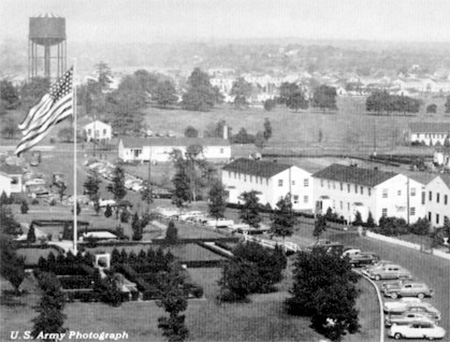
Partial view of Camp Kilmer installations and facilities. Personnel arrived here for their last staging prior to movement overseas. The last preparations were usually made here including such subjects as: abandon ship drill, security and censorship, gas chamber tests, followed by numerous lectures and inspections of clothing and equipment. It should be noted that overall staging for the 131st Evacuation Hospital only lasted 2 days, during which staff and personnel had to pack and prepare for their new assignment overseas.
Officers, Nurses, and Enlisted Men departed for Camp Kilmer, Stelton, New Jersey (Staging Area for New York Port of Embarkation: total acreage 1,815, with a troop capacity for 2,074 Officers & 35,386 EM -ed), where they only had 2 days to pack and prepare their personal belongings for the coming voyage.
On 15 December 1944, the full complement of the 131st Evacuation Hospital entrained for Jersey City. Around the end of the month the organization boarded RMS “Queen Elizabeth” (ex-Cunard Line converted into a troopship, sailed for New York, from where she eventually departed to Singapore for refurbishing and arming, before starting her career carrying Allied troops and enemy PWs across the Pacific and the Atlantic -ed) which was to bring them to the United Kingdom. RMS “Queen Elizabeth” departed NYPOE 7 January 1945 with aboard some 15,000 personnel, including a large number of replacements bound for the European Theater.
United Kingdom:
Upon arrival in Scotland, 13 January 1945, the unit entrained for Altrincham, some 8 miles south of Manchester, Cheshire, England, from where it was instructed to move to another station in Ellesmere, Wales (where more US General Hospitals were stationed). While in Altrincham, the men were billeted in private homes and arrangements were made to mess with other American units stationed in the area. During their stay the personnel took advantage of the many civilian recreational facilities available, such as local theaters and the ARC “Donut Club”. Dances were organized and attended. Meanwhile preparations for a further move were made, orientation lectures held, and detailed inspections of equipment and vehicles conducted. Altrincham was also home to USAAF Station-533 near which the 34th and 39th Evacuation Hospitals were operating.
France:
The organization left the United Kingdom by rail for its staging and marshaling area in March 1945, from where it embarked for the continent on 19 March 45, eventually landing at Le Havre, France on 20 March 1945 where it staged prior to receiving movement orders for a new site located somewhere in Germany.

Photo illustrating some of the world greatest liners, berthed alongside each other at Pier # 90, New York harbor.
From L to R: “Normandie” – “Queen Mary” – “Queen Elizabeth”. The RMS” Queen Elizabeth” arrived in New York 7 March 1940 and remained there until 13 November 1940, when she set sail for Singapore, in order to be serviced and refurbished as a troop transport. During WW2, the “Queen Elizabeth” carried over 750,000 troops and traveled over 500,000 miles.
The 131st then drove by motor convoy through the Grand-Duchy of Luxembourg, Belgium, and Germany, to a site in the vicinity of Becherbach, located within the Bad Kreuznach district, in Rhineland-Palatinate, Germany (approximately 14 miles north of Kaiserslautern -ed) .
Germany:
During April 1945 and in order to supplement the personnel, some civilians mostly consisting of ex-Russian and Polish slave laborers, were hired to work for meals. The hospital was well set up and everything seemed to be going smoothly. Although it rained day and night 11-12 April drainage of the tented area was good. While at its bivouac location the organization received the shocking news that President Franklin D. Roosevelt had died.
As from 13 April 1945, patients slowly arrived, this allowed the hospital personnel some time to smooth out the rough spots. A first operation was performed in the morning by Major Leo L. Marston and Captain Harris (appendectomy -ed). By midnight a total of 35 patients had been admitted;
Patients continued rolling in, a few at a time. Errors in management and operation were being corrected and straightened out. An Officers’ Club was set up in 2 connected tents; and a large GC Red Cross flag erected in front of the Headquarters on a long white wooden pole. On 14 April Chaplain Case held a short memorial service after supper in memory of the late President and Commander-in-Chief, and 2d Lieutenant Groesbeck sang a few special songs and hymns beautifully. News was received the same day that the Allied Armies (read Soviet Forces -ed) were only 35 miles from Berlin, the capital of the Third Reich. Patients continued to be admitted on 16 and 17 April. There was little rain and the overall weather was excellent. 2d Lieutenant Ann Pieters, ANC was promoted to 1st Lieutenant. The daily hospital tasks were accomplished as usual. Operational improvements were made daily. New signs for within the hospital area were painted and put up with extra directional road signs being placed within a radius of ten miles from the hospital site. 1st Lieutenants Roth, Hultgren, Reed and Chaplain Case were promoted to Captains, effective 1 April 1945. With the constant improvements came a morgue tent and arrangements were made with a nearby Quartermaster Laundry Battalion to have operating linen washed by them. A motion picture was shown to all personnel not on duty in the EM’s mess tent at 2300 hours, 18 April 1945. More promotions took place with 1st Lieutenants Claver, Maxwell and Randall now appointed Captains, effective 16 April 1945 (official orders only came through late -ed).
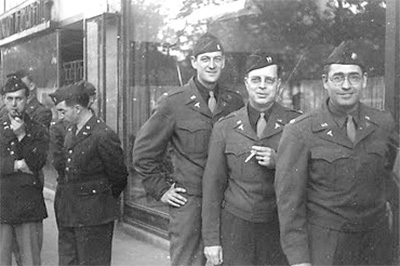
Photo illustrating Officers of the US Army Medical Department off duty, while stationed in the United Kingdom.
Since the unit employed civilians and the number of personnel remained limited, 11 Enlisted Men from another unit were attached for guard duty. 131st Evac drivers and trucks returned from TDY on 20 April. Usual hospital duties continued to be carried out and became routine.
On 24 April, the unit’s Commanding Officer left early in the morning for Fifteenth United States Army Headquarters (activated 21 August 1944 in the ZI -ed) in order to inquire about the hospital’s status and the possibility of occupying buildings instead of canvas tents. He returned at 1900 hours the same day. Movies were now shown every two days.
On 26 April 1945 word was received by message that the hospital was to move in echelons by organic transportation. Colonel D. G. Friend immediately organized a meeting with all Section Chiefs at 0930 and told them to prepare for movement. Preparation was started the next day with EM taking down all squad tents and cleaning up the Enlisted Men’s area. The personnel then moved into ward tents after having cleared out all patients by noon. Good progress was made with the X-Ray, Laboratory, Pharmacy, and Operating Sections the last to be taken down. The OR was left with 1 table for use in case of emergency. By 28 April all Sections were packed and ready to move on short notice. A small amount of personal mail for the unit was received (the first since 8 April 1945 -ed).
On 29 April 1945, Lt. Colonel Thackston, Lt. Colonel Dickworth, and 1st Lieutenant Roth, left on an all-day trip to Headquarters with the main purpose of finding out about movement and to inquire about some missing 15KW generators. Thirty-four (34) more bags of mail arrived and were distributed to the personnel. A Special Service unit showed a motion picture, while some EM were already busy policing the area before movement.
Orders were received by the 131st late in the evening of 30 April 1945 advising to move in two echelons and to have the advance party ready by 0800 hours, 1 May 1945. Destination was to be Sandersdorf, north of Munich, Germany (approximately 241 miles from Munich -ed).
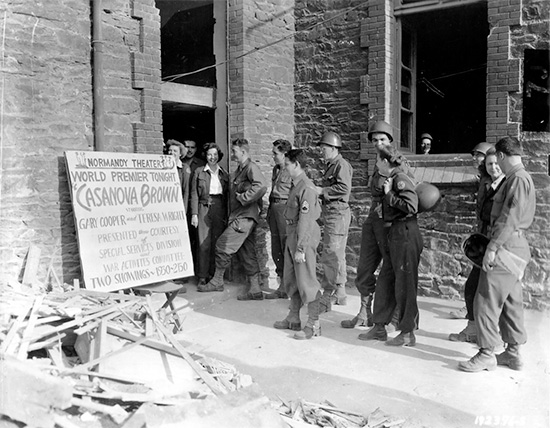
USO (United Service Organizations, 1941-1947) show set up in Normandy, France, to entertain US Army personnel arriving or already stationed in France.
An advance group consisting of 3 Officers and 22 Enlisted Men departed the area at 0800 hours, 1 May 1945, by motor convoy with destination Sandersdorf in Saxony, Germany. In order to keep the remaining personnel busy, a last USO stage show was presented at 0800 hours. It must be stated that it was immensely enjoyed by all.
The first echelon under command of Colonel D. G. Friend and consisting of 6 Officers, 67 EM, and 12 2½-ton trucks, started its journey at 0715, 2 May 1945. All headquarters equipment went with the first echelon together with most of the Operating, Laboratory, and X-Ray Sections materiel. The first echelon arrived at the new site at 2300 hours, where they were met with hot coffee followed by C rations prepared by members of the advance party. They spent the night in squad tents. The following day, all trucks were unloaded, headquarters tents pitched, and around 0900 hours, 3 May 1945, all trucks returned under guidance of 1st Lieutenant Thomas T. Thompson. Enough ward tents were put up to house the remainder of the equipment as soon as it arrived. Thanks to the ARC personnel attached to the 34th Evacuation Hospital, all personnel, 90 in total having arrived at the new location, received a gratuitous PX ration containing 5 packages of cigarettes, pipe tobacco, matches, soap and shaving cream. The electrical system was set up and connected to provide enough lighting. The Army Post Office was Nürnberg (some 159 miles away -ed). The Chaplain from the 34th Evac came over to inform about religious services for the coming Sunday.
On 4 May an advance party belonging to the 139th Evacuation Hospital arrived in the area and their CO visited Colonel Friend. The people were fed by the 131st Evac mess before departing.
More ward tents were pitched to house equipment and personnel. Lt. Colonel Hartridge, Executive Officer of the 66th Medical Group arrived at 1145 hours on 5 May 1945 to hand out instructions and plans for future movement. For the occasion a very fine dinner was served with steak and French fried potatoes. Captain John A. Guinan (the unit’s contact and liaison Officer -ed) left at 1600 hours to reconnoiter and inspect the new location and size up the situation. The second echelon under 1st Lieutenant Robert J. Cassidy finally arrived around 2130 hours with a portion of the organizational equipment and after detrucking were served coffee and steak sandwiches.
On Sunday, 6 May 1945, Catholic staff and personnel were invited by the 34th Evac Hosp Chaplain to Mass and Confession at 0800 and 2000 hours; Protestant services were equally offered.

Reims, France, 7 May 1945. Generaloberst Alfred Jodl (1890-1946) signs the unconditional surrender of Germany.
On 7 May 1945, German Forces were to sign full surrender terms at a small schoolhouse in Reims, France, and President Harry Truman and Prime Minister Winston Churchill made public radio broadcasts announcing V-E Day for 8 May 1945.
Austria:
Colonel Dale G. Friend (CO) and party made a trip to Third United States Army Headquarters on 7 May 1945 to clarify the unit’s status. They were informed that the hospital was to move to the vicinity of Linz, Austria, on a very large and unpleasant job. Part of the group that went to Third Army Headquarters went by truck and on their way back stopped at the 66th Medical Group (which was to become the organization’s next higher headquarters -ed) to pick up medical supplies. Major Robert L. Kushner and Captain John A. Guinan in charge of an advance party left the current Sandersdorf location enroute to the new area.
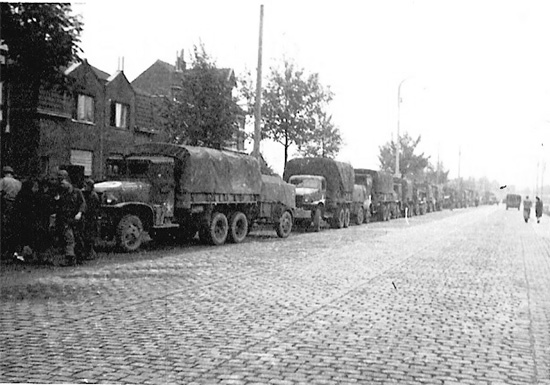
April 1945. Echelon of the 131st Evacuation Hospital motor convoy driving through Belgium. Drivers take a break during the journey to Luxembourg and Germany.
After 7 May 1945, following in the tracks of the Allied liberating forces the unit was on its way to Austria. Following the liberation of a number of German Concentration Camps the US Military Authorities wanted to ensure medical treatment of the sick, weakened, and dying prisoners held in the numerous camps. The recently set up US camp administrations therefore requested the assistance of medical units (they meanwhile often recruited medical personnel from among the former prisoner ranks and sometimes employed local people as nursing staff -ed).
At 0900 hours, 8 May 1945, the various hospital sections commenced work to tear down the camp. By noon, almost three-fourths of the area was taken down and loaded onto trucks borrowed from the 34th, 120th and 130th Evacuation Hospitals. By chow time, around 1700, everything with the exception of personal tents was loaded and ready to move. Word was received to place all the Nurses (39 of them) on TDY for an indefinite period with the 34th Evacuation Hospital which was to set up in the same location.As per instructions, all ANC Officers had left with their personal baggage by 2100 hours.
On 9 May 1945, the 131st Evacuation Hospital was ordered to proceed from Sandersdorf, Southern Germany, at 0700 hours, for Linz, in Austria. Trucks were in convoy lineup, ready to leave in 3 serials; the first one left at 0700 and arrived at the new location around 1600 hours, shortly followed by the second serial. The third only arrived later in the evening. It was during the day that the men realized that by then the war was over in Europe!
The new assignment described in the orders from TUSA, was to set up a hospital in the area of KZ-Mauthausen in order to take care of recently-liberated Polish and Russian DPs (there were of course many more prisoners of different nationalities at the main and subcamps -ed) and to clean, delouse, and refurbish a number of former SS-barracks south of the camp and equip them with the necessary beds. Additional plans were made to establish a ward in another sector of the camp. At first, as indicated, only the male personnel left, the Nurses did not accompany the men. After reaching KZ-Mauthausen and KZ-Gusen, and getting organized on site, the Nurses received orders after a week to join the men there, where they were to help treat the survivors until June 1945. The sick quarters of the concentration camps were systematically evacuated and the patients transferred to the newly-established hospital, together with the seriously ill inmates from the KZ-Mauthausen main camp. The Enlisted personnel were housed in a school in Mauthausen for a short time.
All personnel went out to the concentration camp to look it over and start work – it looked like a hopeless job! The first operation was an all-over cleanup campaign which was started immediately with the help of some former inmates, strong enough to help clean up the buildings and surrounding areas. The personnel were taken on tours through the camps to see the existing conditions and were horrified by the situation.
Five (5) Enlisted Men were attached from the 820th Quartermaster Company for delousing and DDT powder was used on al US personnel to prevent body lice. Buildings were gradually selected and cleaned, a hospital headquarters was completely set up, beds were brought in, and overall cleanliness was greatly improved. During the night of 9-10 May 1945, approximately 30 of the former prisoners died. Concerned with the new situation, Colonel Dale G. Friend tried to make arrangements to build a 1,000-bed tent hospital in addition to his own. Meanwhile a large kitchen formerly used by the German garrison had been cleaned by SS prisoners for use of the 131st Detachment. Medical Supply had been established. A 1500-bed hospital was successfully set up and 118 patients were admitted. The 131st found fine facilities for the Dental Section, the Surgical Section, and the X-Ray Section. Work was also started to improve the Quarry camp and the separate 600-female hospital near KZ-Mauthausen. A Quartermaster Laundry Company was temporarily located nearby for washing and pressing the linen and clothing. On 12 May 1945, additional tentage was erected sufficient to house 380 patients. Camp Gusen I was also improved and taken over.
By this date, a total of 1,804 patients were being treated by personnel of the 131st Evacuation Hospital. Work was started for delousing the entire camps, while general cleanup and sanitary improvements continued every day.

Somewhere in Germany. A WC-54 Ambulance brings patients to an Aid Station set up in the field.
On 13 May, the unit found some German ambulances of which 4 were immediately put into use. One thousand (1,000) German type wool blankets were obtained for the Gusen I hospital. Special diets were prepared for the liberated inmates and 14 Austrian Nurses volunteered to help out caring for the women patients. It was found out that there was great need for the Medical Depot to be closer to the hospital. The hospital was also in dire need of sanitary personnel. The 131st Commanding Officer, Colonel D. G. Friend, MC, was now in charge of the Camp Mauthausen – Gusen I – Gusen II – and the Quarry medical facilities. In order to improve the situation and meet the requirements, work continued on the making of beds and mattresses; spoons and bowls were collected to serve hot soup to the patients; an engineer water point was put in operation close to the installations; and the diet for the hospital patients at Gusen I was increased with bread being served for the first time (although at this time the hospital was running short of flour to bake bread -ed).
It must be stated that reports covering medical conditions, camp facilities, and treatment at the KZ-Mauthausen (main camp), KZ-Gusen I and II, and the so-called Quarry Camp, during the period 9 May 1945 > 15 June 1945, indicated that an estimated 4,000 patients of 22 different nationalities had been hospitalized. Despite the dedicated care and efforts of the 131st Evac, every day saw dozens of former inmates succumb to tuberculosis, typhus, dysentery, and malnourishment (Gusen had a large stone quarry and underground Messerschmitt factories -ed).
On 14 May 1945 a therapeutic team consisting of 2 Officers and 4 Technicians took over the care of 608 patients in the Mauthausen SS barracks hospital. The Registrar’s Office carded all these patients, and 2 Surgeons were appointed per group of 250 patients to record their progress. Portable X-Ray equipment was set up and additional tents pitched to accommodate 1,000 patients, and 600 litters with the necessary blankets prepared. A total of 600 Russian DPs were evacuated from the Russian Lager to the tent hospital, while 80 typhus cases, 20 tuberculosis cases, and 117 cases of severe diarrhea were transferred to the Gusen I hospital. Additionally a large warehouse and a former barracks were prepared to receive them. An Officer was placed in charge of sanitation in the camp and examined all personnel to be released for evacuation from the hospital. Meals were arranged, latrines established, and towels, soap, litters, trucks, immersion heaters, and 24-gallon cans were now in great demand. Captain J. A. Guinan left to attend a meeting at the 66th Medical Group Headquarters, picked up the unit’s mail at Nürnberg, and returned with more Nurses who were now rejoining the 131st. A first, limited, evacuation of DPs from the camp started on 14 May (prior to their shipping out all were sprayed abundantly with DDT). The intention was to return them to their home country as quickly as possible. Around mid-May 1945, the 131st Evac Hosp was caring for a total of 3,286 patients! More supplies continued to arrive the following days but towels and litters were still needed in large quantities. Two (2) more local volunteer Nurses were secured. A large contingent of Poles, 950 in total, left Camp Gusen I on 15 May. In order to supplement the existing personnel, 3 Medical Officers were assigned from the 11th Reinforcement Depot. A Message Center was furnished by the 172d Medical Battalion.
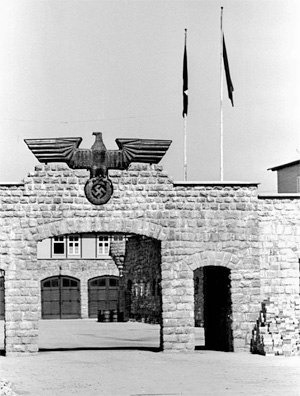
Main Gate of KZ (Konzentrationslager) Mauthausen, liberated by elements of the 41st Cavalry Reconnaissance Squadron, 11th Armored Division 5 May 1945.
An advance group from the 130th Evacuation Hospital arrived on 15 May 1945, with the main body expected the following day. The plan was to install them on the hill near KZ-Mauthausen.
By 15 May 1945, the number of patients treated by the 131st Evac had reached 3,496. A large migration of former Russian prisoners (approximately 1,500 -ed) left Gusen I on 16 May. Camp Gusen I and the surrounding camps showed remarkable improvement, everything looked much cleaner, and some of the American personnel were now occupying former German barracks in lieu of tents. A quick survey revealed that there were 18,000 inmates at Camp Mauthausen; 4,500 at Camp Gusen I; 1,000 in the Quarry Camp; and none at Camp Gusen II. Many of them had been found in the country sides, on edges of roads, wandering, abandoned, trying to leave for home, in search of food, and all ill and in need of great medical care. Of the approximately 28,000 prisoners, at least 5,000 to 6,000 were in need of immediate care. On 16 May 2 additional Medical Officers reported for duty (under limited assignment), they were: Major Frederick W. DeStefano, MC, O-505973 and 1st Lieutenant Robert H. Clymer, Jr., MC, O-469394. Another Officer was also assigned for joining: Captain Robert Bernstein, MC, O-500190. The hospital’s Nurses who had been released from duty by the 34th Evacuation Hospital received quarters at Camp Gusen I. They would be working only on day duty at the camp. Arrival of the 130th Evacuation Hospital, which was to take over the hospital at Camp Mauthausen relieved the workload of the 131st tremendously. The Mauthausen city Mayor cooperated well and furnished the hospital with work details consisting of German civilians while 30 German women helped with the daily cleaning of the wards. Notwithstanding all the help, the hospital was still in need of a Laundry Platoon, more lyster bags, towels, litters, and blankets, and an Ambulance Platoon for transportation.
On 17 May 1945, the 131st Evac Hosp was relieved of its attachment to the 66th Medical Group and attached to XII Corps, APO 312, Third US Army. The total number of patients being cared for now totaled 3,346. A saturation point in the patient census was reached on 18 May. Treatment could only be improved by additional medical personnel which was not readily available. A delegation of the International Red Cross arrived and left 1,000 PW Food Packages No. 10 (supplied by the American Red Cross -ed) which were immediately broken down and distributed. Both the Registrar as well as the Receiving and Evacuation offices were gradually catching up on their records and paperwork. There was quite a spell among the American personnel of upset stomachs and severe diarrhea. With partial evacuation taking place, the total number of patients remaining in hospital decreased to 3,314. By 19 May a recording machine and a loudspeaker system had been set up in the mess hall to provide music during meal hours. The Special Service Officer installed a blackboard outside his office to give the highlights of the daily news. Chaplain Case also displayed announcements indicating scripture readings, miscellaneous bits of news, and information about services. By now all the patients had been furnished with mess equipment as additional spoons, forks, knives, and dishes obtained from local sources. Able bodied former inmates were working hard to repair and improve the water and lighting systems in the camps. There still was a need for toilet articles. A Lieutenant Colonel from the Third Army Surgeon’s Office arrived on 19 May to inspect the complete medical setup; and following his visit, a number of hot showers were made available for the Enlisted personnel. The total number of patients still under treatment reached 3,037.
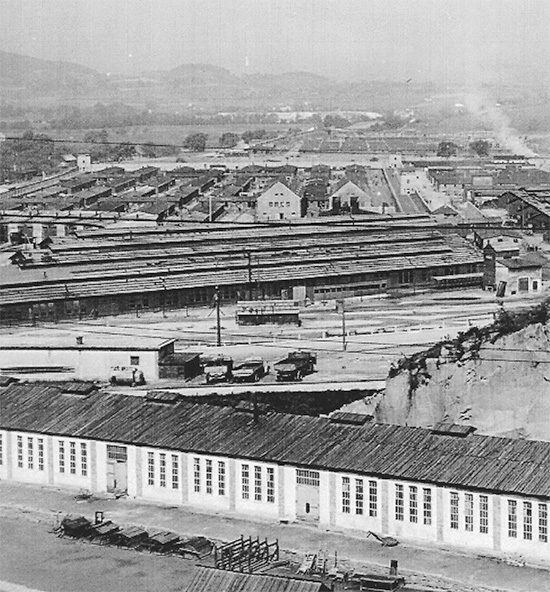
Photo illustrating KZ-Gusen buildings and barracks, following its liberation. To the right is the beginning of the infamous “Stone Quarry” consisting of 195 narrow steps which the inmates had to negotiate during hard labor.
On 20 May 1945, Sunday Morning Services were held for the first time in a nearby small building refurbished and fixed up by the Chaplain and his assistant as a Chapel. The visiting Chaplain from the 121st Evacuation Hospital held services and Holy Mass for Catholic personnel at 0900 hours and Chaplain Chase conducted Protestant services at 1000 the same day. Religious services were also attended by a limited number of the former concentration camp prisoners who were allowed out of the camp. The patient census was 3,178.Unit censorship regulations in the ETO were lifted on 21 May 1945. A new Officer, Major Burnett B. Forman, MC, O-369074 joined the organization and was assigned to the Ward Section, General Duty. The number of patients decreased to 3,031. Quite a number of patients were improving, with the new patient census on 22 May 1945 going down to 2,979.
22 May 1945 was ER Day – Effective Rating Day (setting the individual ASR scores -ed) and the following day 1st Lieutenant Robert J. Cassidy left on a motor trip to TUSA Headquarters to take care of the Adjusted Service Rating cards of the 131st Evac. He was also to discuss and obtain information as to the distribution of PX rations. A large supply of mail arrived and was distributed to the staff and personnel (the first one received since the unit left Becherbach, Germany -ed). Patients census stood at 2,893. Major Elmer Kocovsky was evacuated to another hospital in the rear for diagnosis and further medical treatment. Twelve (12) EM arrived from the 66th Medical Group 24 May to help out as Medical Technicians and a new Medical Officer; Captain Harry J. Parker, MC, O-490538 reported for duty.
An individual showdown inspection took place on 25 May 1945. The Officer in charge of Medical Supply had already started a complete showdown inspection and report of all equipment which was to be submitted to Third Army Headquarters by 30 May. The 39th MRU (Machine Records Unit -ed) was replaced by the 44th MRU. The overall influx of patients slowed down so that those who were being treated received the wholehearted attention they needed. Patients being cared for now totaled 2,637.
The diets for the patients were gradually increased since they showed steady improvement, and the death rate went down. The consequence was that burials now took place every other day instead of daily and a nice camp cemetery was built in a field near the camp. White Crosses and Stars of David in wood were placed over each grave and a white fence eventually girded the burial field. The patient census on 26 May 1945 stood at 2,531. By 27 May 1945 it had decreased to 2,484. Sick in quarters cases still ran high with a large number of them suffering from diarrhea. The headquarters building was equipped with 72 shower heads making hot showers available all night for the hospital personnel. Patients being cared for as of 28 May numbered 2,429. Special rations were received from the 66th Medical Group for exclusive use of DP and RAMP patients who were still in danger of starvation. On 30 May the patient census was 2,301; on 31 May 1945, it was down to 2,180. A supplemental ASR score report was sent in for Officers who had not yet been included in the 22 May report.
As from 1 June 1945 Headquarters began the publication of a Daily Bulletin in order to contact all members of 131st Evac as it was difficult to reach and inform everyone in the area when needed. Seventy-five (75) copies were prepared each day and distributed throughout the hospital installations by 1000 hours each morning, and as much information as possible was placed on the various Bulletin Boards. Thirty-six (36) promotions were announced the same day; 26 of them regarding Privates First Class. The monthly report for May 1945 was sent to higher headquarters (XII Corps). Patient census reached 1,980.
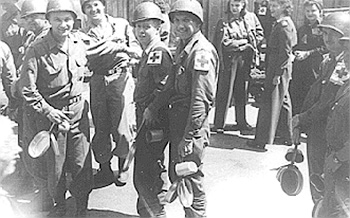
May 1945. 131st Evacuation Hospital medical personnel and ANC Officers wait for chow. Photo taken at KZ-Gusen while treating and caring for the survivors of the concentration camps.
The unit Commanding Officer ordered a complete shift in MAC (Medical Administrative Corps -ed) Officers, effective 2 June 1945. Major M. Peal was relieved from assignment to the organization and attached unassigned to the Detachment of Patients, 32d Evacuation Hospital. The same day, the 610th Medical Clearing Company was relieved and attached to the 130th Evacuation Hospital which was to take over the 131st’s duties. The patients under treatment numbered 1,739. Normal hospital duties were carried out the following days. On 5 June 1945, the 11th Armored Division (which landed in France 17 December 1944, entered Germany 5 March 1945, and liberated the KZ-Mauthausen – Gusen complex 5 May 1945 -ed) sent over the “11th Armored Division Swingsters” who entertained personnel with a grand musical show in the mess hall. The 21st Armored Infantry Battalion sponsored a V-E Day celebration program with music, dance, track meet, boxing exhibition, etc. and invited all 131st Evac personnel to attend. The patient census stood at 1,285.
On 6 June 1945 news was received that the unit was now operating under XX Corps instead of XII Corps. Another Medical Officer (N-P) joined from the 6th Convalescent Hospital; Captain John F. Sullivan.
A special Redeployment Roster was sent in with the Daily Morning Report for 7 June. It concerned the ASR scores of the Enlisted Men. A Colonel attached to SHAEF, arrived for inspection of the hospital and especially looked over the situation regarding malnutrition of the patients. The movie projector ordered some time ago finally arrived enabling the organization to show movies more frequently. During a special presentation every member of the command was reminded that the “Seventh War Loan” drive was on and that personnel should take out a new class “B” allotment.Patients now totaled 1,240. A very nice area was located and prepared by the EM for a softball field. It was used by the intra-Hospital Softball League. Fishing holes were found for the men who desired to go on a fishing trip on their days off. By 8 June the patients census decreased to 1,161. Two Third US Amy inspectors arrived, and held talks with Colonel Dale G. Friend, Commanding Officer and Captain Margaret Burton, Chief Nurse who took them through the hospital.
Tours were arranged as from 10 June 1945 every afternoon for those who desired to visit the Monastery at St. Florian. ANC Officer 1st Lieutenant Jennie P. Benefiel joined the 131st Evac after having been relieved from assignment with the 35th Evacuation Hospital. She finally brought the number of Nurses to 40. A meeting of all Sections Chiefs was held the evening of 12 June to determine the recommended changes in T/O & E which were eventually forwarded to TUSA Headquarters. A Captain Pate of the 65th Infantry Division Surgeon’s Office called to find out exactly how many patients could be evacuated. Colonel Robert L. Callison, MC, Commanding Officer of the 130th Evacuation Hospital phoned Colonel Dale G. Friend to inform him that possible movement orders for the 131st were on their way.The long-awaited Post Exchangenow opened daily (as from 12 June 1945 -ed) from 1200 until 2100 hours, with cold beer available to staff and personnel. Although rations were sufficient, there was however a lack of cigarettes during the month. Since the unit was stationed so far into Austria it was a long way to the available Army Supply Depots.

May 1945. Open-air and indoor treatment of female patients by Austrian Nurses and ANC Officers of the 131st Evacuation Hospital near the reserved camp hospital at KZ-Gusen I.
On 13 June 1945 the 131st Evac Hosp CO left early in the morning for XX Corps Headquarters to find out the unit’s status. Movement was expected, but nobody knew when and where! Additional trucks had to be ordered to carry out the movement, as the 131st only had 20 of these (another 30 were requested -ed). The Ward Section meanwhile started preparations by collecting folding cots and wool blankets. The unit was to leave all expendable items on site for the unit to succeed them.
An advance party from the 59th Field Hospital arrived to replace the 130th Evac Hosp at Camp Mauthausen. Another group pertaining to the 59th Field Hospital accompanied by the 616th Medical Clearing Company also arrived on 13 June to take over operation from the 131st Evac. As a result of the orders for movement, the organization was now attached to XV Corps per Vocal Orders, Commanding General, Third United States Army, dated 10 June 1945. From 13 June 1945 all Daily Morning Reports were to be sent to the 54th Machine Records Unit, APO 436.
Following the receipt of new instructions, the 131st Evac was ordered to complete all operations and issue their final reports prior to departure for the Assembly Area Command (AAC), Camp Philadelphia, France, per Movement Order ref. Letter Headquarters XV Corps, Third United States Army, dated 13 June 1945 (the unit had received definite word that they were going to move, pack, and turn over the various sections to the 59th Field Hospital on 14 June 1945 -ed).
Station Location and Strength – 131st Evacuation Hospital
Location: east of Linz, Austria (V 8886)
Overall Strength: 32 Officers – 1 Warrant Officer – 40 Nurses – 205 Enlisted Men

KZ-Gusen I, small building refurbished and taken over by the 131st Evacuation Hospital Chaplain to serve as a temporary Chapel.
A continuous and gradual process of turning over the different sections to the 59th Fld was started 14 June. At 1300 a formation of the 131st Evacuation Hospital Detachment was held at which time a roll call was held and all personnel present were officially advised that the unit was now placed on an “alert” status for movement. A copy of the organization’s final roster was attached to the Morning Report and submitted to the 54th MRU for processing. Major Leo L. Marston was still on TDY in Brussels carrying out instructions of the Commanding Officer. A XV Corps team arrived to inspect the organization’s records; it was very thorough lasting almost 2 days and discrepancies found were not too prevalent. Sections were gradually turning over work and expendable property throughout 14 and 15 June 1945 to the 59th Field. The recent athletic program was now in full swing. Medical Supply put out a list of minimum essential items to all Sections instructing them as to what should be carried to be handy for the coming trip. The only Sections still operating on 15 June were Hospital Headquarters; Detachment of Patients Headquarters; Postal Section; and the Registrar Office. The latter was busy transferring all remaining patients to the 59th Field Hospital and closing all its records. Patient census at this date was 1,019.
The 59th Field Hospital finally took over from the 131st Evacuation Hospital (and the 130th Evac Hosp who remained in Camp Mauthausen until 16 June 1945 -ed) 15 June 1945 and established 3 separate hospitalization units to provide the necessary medical care for the DPs remaining in the vicinity of KZ-Mauthausen and KZ-Gusen I. Considering the delicate and important task that awaited them, they were eventually supported by personnel of the 616th Medical Clearing Company who remained on site until 20 June 1945. All remaining cases were eventually transferred to an Austrian civilian hospital in Bad Ischl, Austria, on 23 June 1945 (Soviet Forces occupying the sector began dismantling the KZ-Gusen underground installations and equipment 10 September 1945 -ed).
Ultimate Movement in the ETO:
All records were closed on 16 June 1945 and the 131st was no longer operating as a hospital! The only Sections still functioning were Medical Supply, Mess Section, and Unit Supply. Sports, fishing and swimming in groups of three or four remained available. Arrangements were under way to award all eligible personnel the Driver’s Badge.
During 17 – 18 – 19 – 20 and 21 June 1945 quite a few changes took place including returns, transfers, losses and promotions of both staff and personnel.
Major Leo L. Marston, MC, returned from TDY in Brussels 16 June 1945.
1st Lieutenant Jessie E. McIntyre, ANC, was relieved of duty and assigned to the 59th Field Hospital 17 June 1945.
Captain Charles Bernstein, MC, who had not yet joined was relieved from assignment 18 June 1945.
Colonel Dale G. Friend, MC, Commanding Officer, was relieved from his command and assigned to the 101st Evacuation Hospital (SM) 20 June 1945.
Staff Sergeant Earl C. Minninger was promoted to Technical Sergeant effective 19 June 1945.
Lt. Colonel Angel A. Cardona, MC, was transferred to the 101st Evacuation Hospital (SM) 20 June 1945.
Captain Francis N. Cooke, MC, joined from the 101st Evacuation Hospital (SM) 20 June 1945.
Captain Jacob R. Schwartz, MC and 1st Lieutenant Evelyn C. Stewart, ANC, joined from the 101st Evacuation Hospital (SM) 20 June 1945.

Photo illustrating the cemetery and signpost set up by the 131st Evacuation Hospital at Gusen, Austria.
The final Daily Morning Report went out prior to departure for the Assembly Area Command in France and was dated 21 June 1945.
On 22 June 1945, the organization was enroute for the Assembly Area Command in France. The 131st Evac Hosp departed Camp Gusen, Austria, by motor convoy, leaving at 0800 hours, arriving at Enns, Austria, at 0930 hours, the same day. It left Enns at 1345 hours via rail, passing through Salzburg at midnight. The group continued its journey reaching the vicinity of Stuttgart, Germany, at 2400 hours, 23 June 1945. After traveling approximately for another twenty-four hours, the organization stopped in Nancy, France the next day.
Camp Philadelphia, one of the many City Camps established in the Reims area, France was reached at 1200 hours, 25 June 1945.
Two (2) Enlisted Men were transferred to the 320th and 319th Reinforcement Companies respectively. Another 12 attached EM were relieved and returned to the 170th General Hospital and one Technician was assigned and transferred to the 10th Reinforcement Depot. The organization soon returned to its usual duties.
On 27 June 1945, Lt. Colonel Angel A. Cardona assumed command, as per Paragraph 1, General Orders # 8, Headquarters, 131st Evacuation Hospital (SM). Some promotions took place the same day, including Technician 3d Grade Walter G. Keithly who became a Technical Sergeant and Technician 4th Grade Arthur C. Peterson who received a promotion to Technician 3d Grade.
More changes and transfers were to take place before the organization received orders to prepare for one last movement that would return them to the Zone of Interior and inactivation … it is most likely that the 131st Evac was transferred to a Staging Area in Northern France, to eventually board a ship at Le Havre for its last crossing of the Atlantic.
The MRC Staff are looking for additional information relating to the Hospital’s stay in the European Theater and its return to the Zone of Interior. A complete Unit Personnel Roster would also be most welcome. Thank you.
